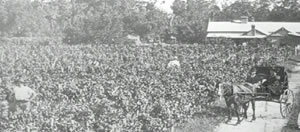FAIRFIELD CITY
Early settlers were attracted to the Fairfield district by its good soil, dependable water supply and easy access to the Colony's established towns. On the other hand, it lacked basic features. Major thoroughfares such as the Great Southern, Dog Trap, Wallgrove and Cowpasture roads all skirted the area, and the network of creeks interfered with the direct transit of local traffic.
This rustic isolation might have continued indefinitely but for the choice of Fairfield as the sole intermediate station when the railway line was extended from Parramatta Junction (now Granville) to Liverpool. The line opened in September 1856, exactly one year after the State's first railway line between Sydney and Parramatta Junction and the rail link provided Fairfield with the stimulus for growth. The availability of transport for bulk freight brought the expansion of local industry such as timber cutting, fruit-growing and other farm produce. As the township grew, the station became like the hub of wheel, with the streets of Fairfield leading towards it.
INDUSTRIES: Development of a business area around the Fairfield station was slow. Timber cutting was the main industry of the little township, and the first sawmill belonged to Arthur Stimson. Most of the timber came from Stimson's own estate at Fairfield West, though he also employed teams to haul timber from other parts of the district. In the 1880's, the only houses in the Crescent belonged to Harry and George Stimson, both of whom owned vineyards along
the banks of the Orphan School Creek in Fairfield West.

George Stimson's Vinyards at Fairfield West 1895
Most of the activity in the early days of the railway stemmed from the sawmill, the rail trucks being loaded straight from the mill. Another sawmill was established nearby and was owned by a man named McGuaarr, but the business did not succeed and he became a blacksmith in Smithfield.
Commercial activity in Fairfield began in a small way and among the first to take advantage of the district's possibilities was George M. Wheatley. Trading as M. A. Wheatley, he opened a small business in Hamilton Road, Fairfield West during the1880's. It prospered and with the growing population, Wheatley decided to build a substantial shop in the Crescent opposite the railway station.
By the early years of the twentieth century, Fairfield had become a typical country town with paddocks behind the main street and a magnificent display of gum trees and wattle.
Timber mills and tanneries were still the district's main industries, though by then there was also a tile works at the end of Wilga Street. It had been started in 1895 by the two Symons brothers, who came from generations of terra cotta craftsmen in Somerset. The clay deposits in Fairfield Between Taylor Street and the banks of Orphan School Creek were particularly suitable for their purpose, and within a few years the business had expanded having a drying shed holding 120,000 tiles, and kilns able to process 70,000 tiles.
Apart from the two-storey structure called the Central Building in the Crescent, little commercial development which took place before World War I. In common with other Australian towns, Fairfield felt the loss of the young men as they went to war. The women and the older men managed to keep the market gardens and orchards going, but the timber industry and the building trade came almost to a standstill
After World War I there was a remarkable change in Fairfield. A great many new houses were built and by 1921 the population had increased from three thousand to nine thousand.
Like the rest of Australia, Fairfield expanded in the boom years of the 1920's only to have the good times wiped out suddenly and savagely by the Depression in 1929. In some ways, Fairfield was fortunate as much of the labour force was concentrated on the land, rather than in the hard-hit secondary industry. Nevertheless, the number of unemployed in the community gradually increased. Relief organizations were set up, including the Fairfield Unemployed Committee, a group, which arranged concerts and boxing tournaments at the Plaza and other functions as benefit nights. Local theatrical groups also played their part in raising funds, notably the Fairfield Players Club and the Revusicals.
Employment and unemployment
The level of overall employment of Fairfield residents has not increased over the eight years from 1988 to 1996. Considering the substantial population increases over this period, this means that employment of Fairfield residents has deteriorated and not recovered as the national economy moved out of recession.
The total employment levels of male residents actually fell over this period.
Levels of full-time employment fluctuated widely over this period, but without increasing, while part-time employment fluctuated less and has increased
The numbers of Fairfield residents employed in manufacturing has declined between 1988 to 1996 by approximately 10,000, and these were likely to have been full-time jobs lost. As this industry is the major employer of Fairfield residents, this has had major impact on unemployment rates in the area, particularly for men.
The unemployment rate for Fairfield was 14.8% at June 1996 that is approximately double the NSW rate of 7.8%, and this has been the pattern for many years.
Source: -George, Vance. Fairfield: history of the district.
-CLIB